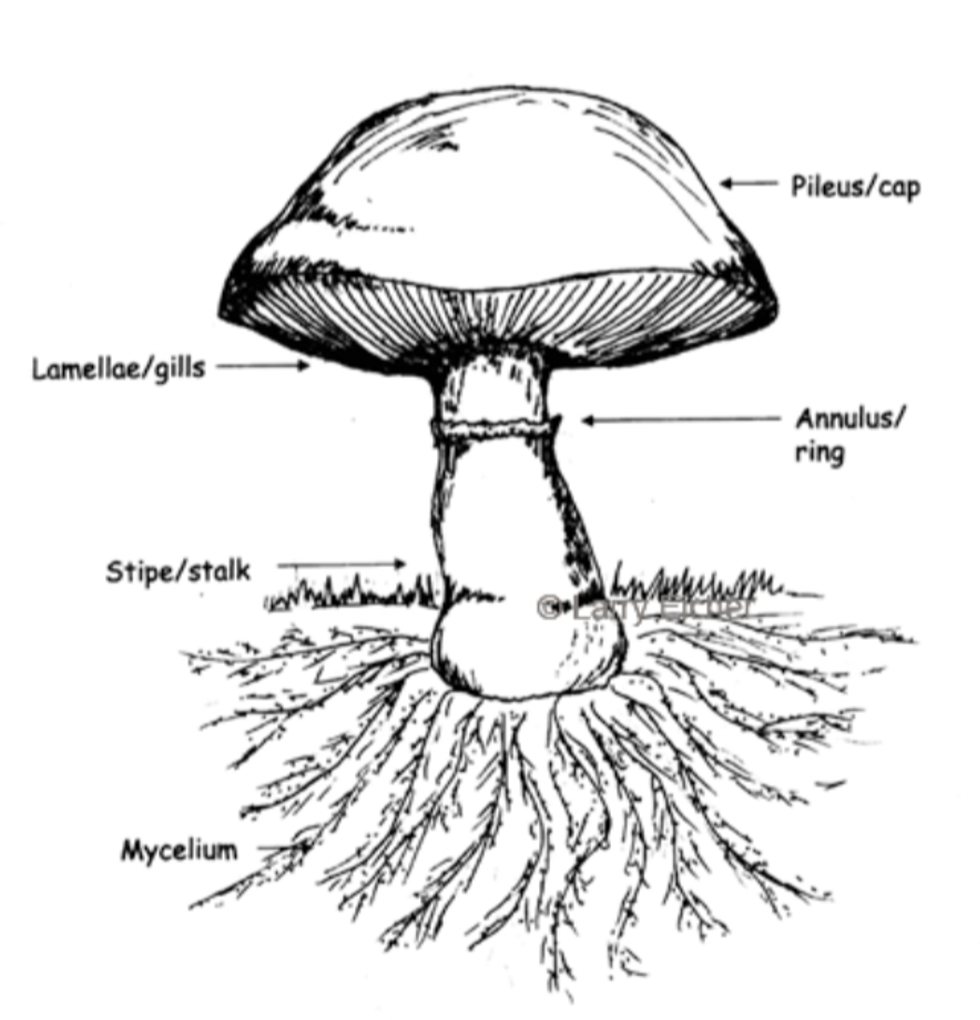What Mushrooms Are and Are Not
Mushrooms are umbrella-shaped fungi with two parts, as shown in Figure 1. The underground part is known as the mycelium, a web of numerous, hair-like fibers called hyphae. The mycelium network helps mushrooms absorb nutrients from their environment (e.g., log) in a two-step process. First, the hyphae release enzymes into the substrate in order to break down the polymer material into monomers. Then, the mycelium absorbs the monomers via transportation mechanisms know as facilitated diffusion and active transport.
The top portion that many of us see is the fruiting-body (sporophore). The stalk or stem supports the cap until the time is right for spore dispersion. The ring is tissue that protects the gills during development. Gills are plates located under the mushroom’s cap and their purpose is to hold the spores. The cap helps to protect the gills and spores below it.
Fig 1. Anatomy of a mushroom
Mushrooms are not plants. Here are some of the notable differences:
- Plants belong to the kingdom plantae. Mushrooms are members of the kingdom fungi, which includes microorganisms like yeasts and molds.
- Plants contain chlorophyll, a molecule that gives them their green color and allows them to make their own food and energy via a process known as photosynthesis. Mushrooms do not contain chlorophyll and cannot make their own food and energy through another means, so they live in relationships with other organisms.
- Plants reproduce through pollen and seeds, while mushrooms reproduce through spores.
- Plants cell walls are created from cellulose, while those of mushrooms are made of chitin.
Mycoremediation
Mycoremediation is the art of using fungi, such as mushrooms, to degrade contaminants from the environment. The following is a list of several contaminants that mushrooms help denature: herbicides, TNT, hydrocarbons (e.g., crude oil and natural gas), organophosphates (pesticides), and anthracene (coal tar). By eliminating the aforementioned contaminants and many others, there is promotion of healthy soil and the soil can provide nourishment for the biota living in it.
Health Benefits
Mushrooms have been used for many centuries in Traditional Chinese Medicine. In recent years, scientific research has supported many of the effects for which mushrooms have been used in the Chinese culture, as well as others. Among the backed benefits, include:
Enoki: Long, slender white mushrooms that have demonstrated anti-cancer and immune-enhancement properties.
Shiitake: These type of mushrooms have shown anti-tumor, cholesterol-lowering, and antiviral effects if eaten on a daily basis.
Oyster: Common edible mushrooms that have anticancer properties.
Maitake: Also called the “hen of the wood,” this class of mushrooms provide protection against cancer. Plus, maitake mushrooms can regulate blood pressure and blood sugar.
Dangers
Not all mushrooms are beneficial. In fact, some are very poisonous, causing anywhere from illusions to liver damage to death when ingested. Watch out for these 7 poisonous mushrooms: death cap (Amanita phalloides), Conocybe filaris, webcaps (Cortinarius species), autumn skullcap (Galerina marginata), destroying angels (Amanita species), Podostroma cornu-damae, deadly dapperling (Lepiota brunneoincarnata).
Extra Information
Want to learn more about the kingdom that mushrooms belong to? Visit http://www.ucmp.berkeley.edu/fungi/fungi.html. Want to know 6 ways how mushrooms can save the world? Check out Paul Stamets’s Ted Talk.

















